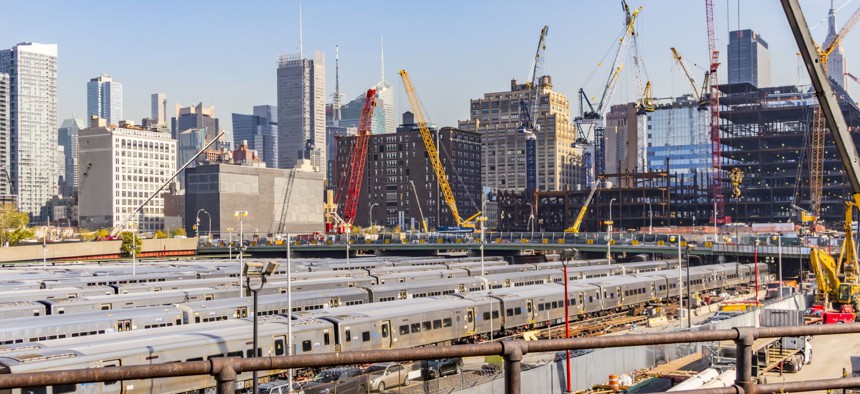As White House Formulates Infrastructure Plan, Talks With State and Local Groups Continue

Hudson Yards on the west side of Manhattan Shutterstock

Connecting state and local government leaders
“I would say that there's been direct communications at least once a month for the last several months,” said a staff member with the National Governors Association.
State and local government groups have met multiple times with White House officials in recent weeks to discuss the infrastructure package that President Trump has identified as a priority.
Representatives from two organizations—the National Governors Association and the National Association of Counties—indicated in interviews this past week that the plan remains a work in progress and that it is still unclear how much federal funding any eventual package might include for states and localities.
Trump has said he wants to see a $1 trillion infrastructure program that relies on both public and private capital. He suggested earlier this month he may seek to speed up his pursuit of this goal.
“I think there are a lot of different meetings going on and I've been on phone calls and also in in-person meetings,” said Anna Davis, the National Governors Association’s director of government relations, as she discussed the group’s interactions with the White House concerning infrastructure.
She added: “I would say that there's been direct communications at least once a month for the last several months and sometimes two or three times.”
Davis said NGA staff had met with DJ Gribbin, special assistant to the president for infrastructure policy, along with others working on infrastructure issues within the White House.
“He's been very, very responsive,” Davis said of Gribbin, who previously led advisory teams at Macquarie Capital structuring public-private partnership deals for government clients. Gribbin also has prior experience within the U.S. Department of Transportation.
As for the balance between federal funding in an infrastructure package versus incentives like tax credits designed to spur private investment in public works, Davis said of the administration: "I think they're still thinking that through.”
Meetings between White House officials and the NGA took place as recently as this week. The meetings have so far involved the organization’s staff, not governors, according to Davis. But she said the Trump administration could be reaching out to governors separately.
The National Association of Counties is among the other groups that have been in contact with the administration about the possible infrastructure package, according to Deborah Cox, the group’s legislative director.
“It sounds like a lot of it could be based on private sector involvement in infrastructure,” Cox said, describing what she’d gleaned from discussions so far. Asked if there had been indications as to how much direct federal funding could be part of any forthcoming plan, Cox replied: “I think that is the biggest question that everyone around town is asking.”
“They are still formulating what their proposal will look like,” she added.
Governors in February sent a list to the White House of 428 “shovel-ready” infrastructure projects, in 49 U.S. states and territories, that they considered priorities. Davis said the conversations between the NGA and the Trump administration had not revolved around the list. “They tend to be more general.”
Davis said the list didn’t feature a compilation of projects that were easy to compare. “It's very helpful to get a sense of the kinds of projects in the states, but there would need to be more refinement to really be able to determine the readiness for some of those,” she said.
It wouldn’t be possible, according to Davis, to “sit down with that list and make decisions on how to go forward.”
Both Davis and Cox said their groups are advocating for whatever proposal is put forward to include a range of approaches for addressing deficiencies with infrastructure—a term that can refer to assets such as roads, airports, broadband networks and water systems.
Davis pointed out, for example, that while tolls might work to generate revenue for road projects in some places, they might not be a realistic option in others.
Preserving the federal income tax exemption for interest earned on municipal bonds is a priority for the National Association of Counties. “That’s the primary way that we build and maintain a lot of our infrastructure,” Cox said of the bonds.
The tax exemption is believed to keep borrowing costs for municipal bonds lower than other types of financing.
Trump discussed infrastructure in an interview with The New York Times earlier this month. “We’re going to have a very big infrastructure plan. And bill. And it’s going to come soon. And I think we’ll have support from Democrats and Republicans,” he said.
“I’m thinking about accelerating it,” he added, according to a transcript of the interview. “I’m thinking about putting it with another bill. Could be health care, could be something else … Could be tax reform.”
The Trump administration’s legislative agenda got off to a rough start this year when a GOP-led effort to roll back the Affordable Care Act, also called Obamacare, collapsed. The health care legislation ignited disagreements between House Republicans and was a nonstarter for Democrats.
Infrastructure is generally seen as a rare area where bipartisan agreement could be possible in Congress.
“But there has to be something for everybody in there to bring them to the table,” Davis said. “There needs to be some federal funding in there. But that certainly is just one of the pieces.”
Bill Lucia is a Senior Reporter for Government Executive’s Route Fifty and is based in Washington, D.C.

NEXT STORY: Microsoft’s 5 Steps to Urban Cyber Resilience





